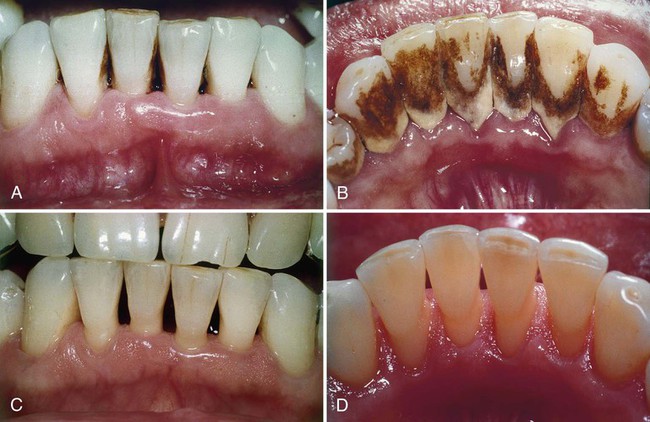Phase I Periodontal Therapy
Phase I therapy or cause-related therapy10 is the first in the chronologic sequence of procedures that constitute periodontal treatment. The objective of phase I therapy is to alter or eliminate the microbial etiology and factors that contribute to gingival and periodontal diseases to the greatest extent possible, therefore halting the progression of disease and returning the dentition to a state of health and comfort.5 Phase I therapy is referred to by a number of names, including initial therapy,5,10 nonsurgical periodontal therapy,18 cause-related therapy.10 All terms refer to the procedures performed to treat gingival and periodontal infections, up to and including tissue reevaluation, which is the point at which the course of ongoing care is determined.
Rationale
Phase I therapy is defined by the evidence-based American Association of Periodontology practice guidelines5 as the initiation of a comprehensive daily plaque control regimen, management of periodontal-systemic interrelationships as needed, thorough removal of supra and subgingival bacterial plaque biofilm and calculus, chemotherapeutic agents as necessary, and elimination of local factors1,2,3,4,6 such as defective restorations and treatment of carious lesions.7,9,15,16,20 These procedures are a required part of periodontal therapy, regardless of the extent of disease present. In many cases, only phase I therapy will required to restore periodontal health, or it will constitute the preparatory phase for surgical therapy. Figures 44-1 and 44-2 show the results of phase I therapy in two patients with chronic periodontitis. The goal of cause-related phase I periodontal therapy has been succinctly stated as the approach aimed at removal of pathogenic biofilms, toxins and calculus, and the reestablishment of a biologically acceptable root surface.10


Phase I therapy is a critical aspect of periodontal treatment. Data from clinical research indicate that the long-term success of periodontal surgical treatment is dependent upon maintaining the plaque biofilm control results achieved with phase I therapy. In fact, patients who do not have adequate plaque biofilm control will continue to lose attachment regardless of what surgical procedures are performed.12 In addition, phase I therapy provides an opportunity for the dentist to evaluate tissue response and provide reinforcement about home care, both of which are crucial elements to the overall success of treatment.
1. Complete removal of calculus (see Chapters 46 and 47)
2. Correction or replacement of poorly fitting restorations and prosthetic devices (see Chapter 67)
3. Restoration or temporization of carious lesions
4. Orthodontic tooth movement (see Chapter 51)
5. Treatment of food impaction areas
6. Treatment of occlusal trauma (see Chapter 50)
7. Extraction of hopeless teeth
8. Possible use of antimicrobial agents including necessary plaque sampling and sensitivity testing (see Chapters 8 and 48)
Treatment Sessions
After careful analysis and diagnosis of the specific periodontal condition present, the dentist must develop a treatment plan that includes all required procedures and estimates the number of appointments necessary to complete phase I therapy. In most cases, patients require several treatment sessions for the complete debridement of tooth surfaces. All of the following conditions must be considered when determining the phase I treatment plan18:
Sequence of Procedures
Step 1: Plaque Biofilm Control Instruction.
Plaque biofilm control is the essential component to successful periodontal therapy, and instruction should begin at the first treatment appointment. The patient must learn to correctly brush the teeth, focusing on applying the bristles at the gingival third of the clinical crowns of the teeth, and begin using floss or other aids for interdental cleaning. This is sometimes referred to as targeted oral hygiene22 and emphasizes thorough biofilm removal around the periodontal tissues. The multiple appointment approach to phase I therapy permits the dentist to evaluate, reinforce, and improve the patient’s oral hygiene skills. (Chapter 45 details plaque control options.)
Step 2 Removal of Supragingival and Subgingival Plaque Biofilm and Calculus.
Removal of calculus is accomplished using scalers, curettes, ultrasonic instrumentation, or combinations of these devices during one or more appointments. Evidence suggests that the treatment results for chronic periodontitis are similar for all instruments.12,13 In addition to calculus removal, bacterial plaque biofilm and some cementum are removed by instrumentation procedures as a matter of course. At one time it was thought that all cementum had to be systematically planed off of root s/>
Stay updated, free dental videos. Join our Telegram channel

VIDEdental - Online dental courses


